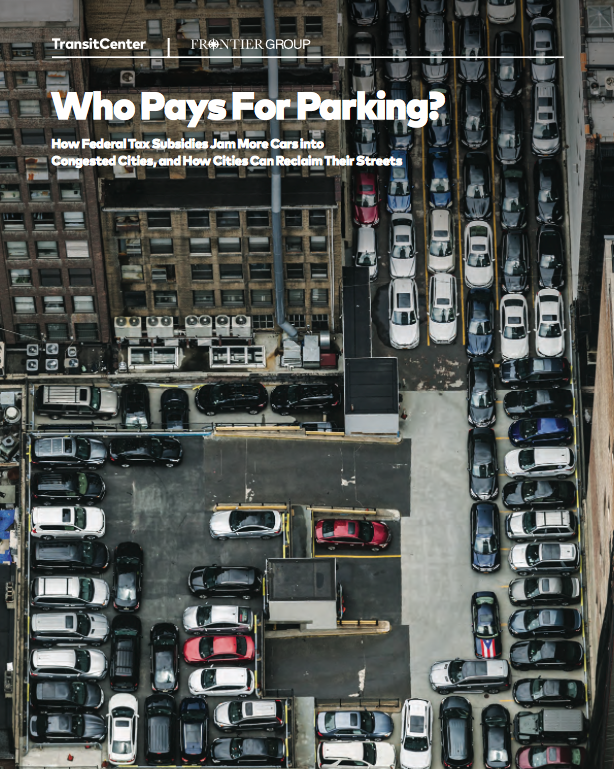Who Pays for Parking? Unraveling the Hidden Subsidies that Clog Our Streets
Today we're featuring a guest article from Strong Towns member Tony Dutzik, announcing Frontier Group's release of a new report about parking. Frontier Group provides information and ideas to help citizens build a cleaner, healthier and more democratic America.
America’s dependence on the car is reinforced by a tapestry of rules, practices and norms that make driving relatively easy and cheap and other options comparatively difficult and expensive. Pull on any one thread, and the rest of the tapestry just seems to tighten and become stronger.
Three years ago, Frontier Group teamed up with TransitCenter to study the impact of one of those public policy threads – the tax-free treatment of most commuter parking – in a report called Subsidizing Congestion. We estimated that the subsidy cost federal and state governments $7.3 billion in lost tax revenue each year, even as it put an additional 820,000 cars on the road in our most crowded cities at precisely the points in time – rush hours – when they do the most to create congestion.
This month, we joined with TransitCenter again to release a new report, Who Pays for Parking?: How Federal Tax Subsidies Jam More Cars into Congested Cities, and How Cities Can Reclaim Their Streets, which explores how cities can limit the damage caused by the federal tax code and how the federal government can rethink commuter benefits to reduce, rather than reinforce, car dependence.
The commuter parking tax subsidy has been around, in one form or another, since the dawn of the Automobile Age. It was only in 1992 that Congress created a parallel tax benefit for transit commuters – a benefit that our 2014 report found incentivizes people to travel by transit but simply doesn’t reach enough Americans to compensate for the damage caused by the parking tax subsidy.
Removing the parking tax subsidy from the transportation policy tapestry is not easy. Besides the obvious political difficulties, putting a taxable value on commuter parking is not a simple nor a straightforward thing to do. And there is good reason to be concerned that removing the parking tax benefit would result in losing the transit benefit – which many people and transit agencies rely on and which serves a useful public policy purpose – along with it.
So, while reforming commuter benefits at the federal level should be the end goal, the best place to start addressing commuter parking may be in the cities that bear the burden of our current policies in clogged streets and greater maintenance needs. Who Pays for Parking? reviews some of the many tools cities have to reclaim their streets. One approach – employed by cities from the Bay Area to New York City to D.C. – is to require large employers to offer commuter transit benefits to their employees. While many of these “commuter benefits ordinances” are new, early evidence from the Bay Area suggests that the extension of transit benefits has led tens thousands of people to switch to lower-impact modes of commuting.
Another option for cities is to reclaim some of the public subsidies extended to auto commuters by taxing parking. Many U.S. cities do this to some degree, with some reinvesting revenues from taxes on parking garages into transportation improvements that expand options for residents. Other cities around the world go further – Nottingham, England, for example, assesses an annual fee on all parking provided by employers, even those spaces provided to workers for free. The proceeds have thus far helped to finance the construction of two new tram lines, along with other transit improvements. Since the parking tax went into effect, transit ridership is up, more businesses have chosen to locate in the city, and there has been no increase in car traffic. That’s a win-win.
But while cities can do a great deal to reduce the impact of the commuter parking subsidy, it will ultimately be up to the federal government to develop a comprehensive commuter benefits policy that meets 21st century transportation needs. We recommend that federal officials look to the example of other nations that tax the value of commuter parking for ideas about how to implement a similar system here in the United States.
We also recommend that the federal government revisit the transit and vanpool tax benefits to reflect today’s changing transportation opportunities and needs. One priority would be to expand access to the benefit to the self-employed and workers in the “gig” economy. This is particularly important given the rise of non-traditional employment arrangements. In addition, the federal government should make newer transportation services that contribute to reducing congestion and environmental impacts – such as bikesharing – eligible for commuter benefits, and consider following the example of countries such as Belgium and the Netherlands that allow employers to make tax-free payments to employees who walk or bike to work.
Unraveling the subsidies that reinforce car dependence and clog our streets won’t happen overnight. But if America is to meet its transportation, public health and environmental goals, we need to start now. Cities can use their policy muscle and role as policy innovators to counteract the effects of the short-sighted federal tax subsidy for commuter parking. If enough of them take the leap, perhaps federal officials will follow suit to bring the entire suite of commuter tax benefits into the 21st century.
(Top photo source: Tony Webster)

